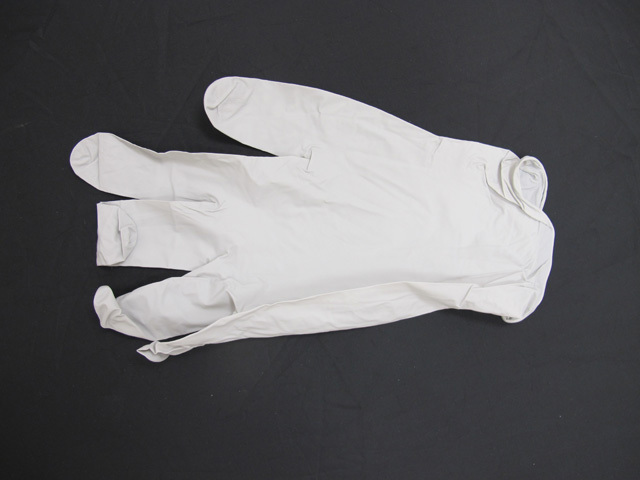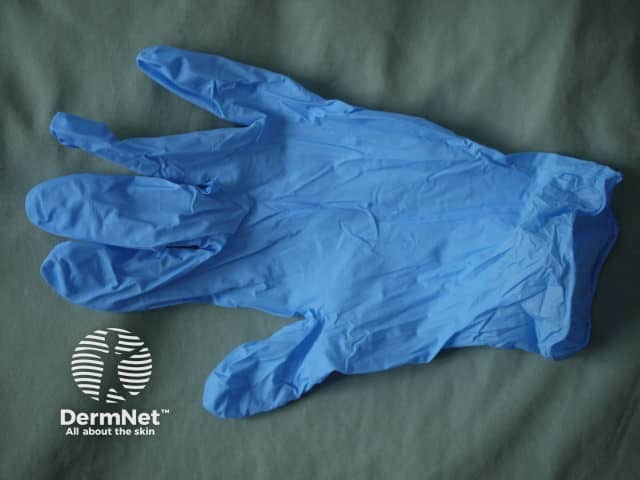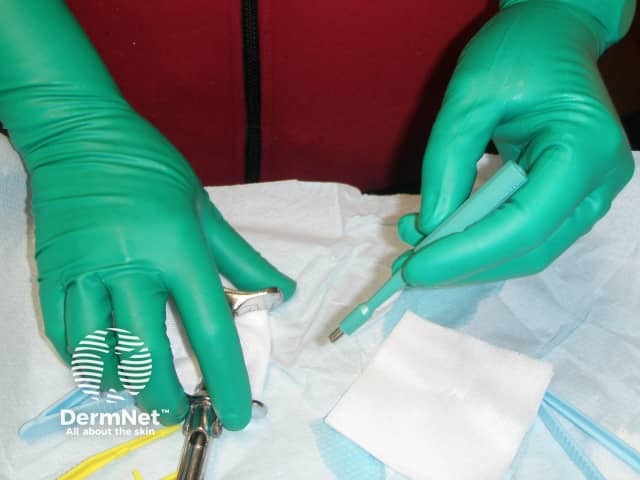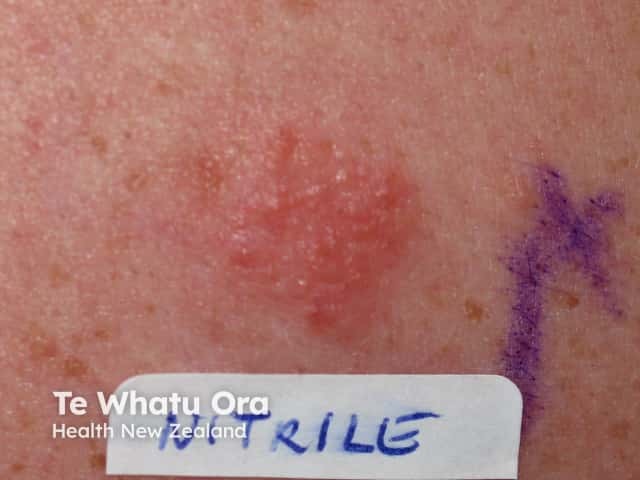Main menu
Common skin conditions

NEWS
Join DermNet PRO
Read more
Quick links
Authors: Dr Nicholas Manuelpillai, Dermatology Resident, St Vincent’s Hospital, Melbourne, VIC, Australia; A/Prof Rosemary Nixon, Dermatologist, Occupational Physician and Director; Skin Health Institute, Melbourne, VIC, Australia. DermNet Editor in Chief: Adjunct A/Prof Amanda Oakley, Dermatologist, Hamilton, New Zealand. Copy edited by Gus Mitchell. March 2020.
Introduction
Uses
Demographics
Causes
Clinical features
Diagnosis
Treatment
Outcome
Contact dermatitis is an eczematous skin reaction arising from direct contact with a causative agent. It is the most common type of occupational skin disease. Contact dermatitis is classified as either allergic contact dermatitis or irritant contact dermatitis or a combination of both.
Contact dermatitis to nitrile is mostly allergic contact dermatitis, but irritant contact dermatitis may also occur.
Nitrile is an organic compound most commonly used to produce nitrile rubber. Nitrile rubber is a large synthetic rubber, a copolymer of acrylonitrile and butadiene, used in the production of latex-free gloves. Nitrile rubber is also used to produce transmission belts, seals, and hoses.
Nitrile is also used in the production of insecticides and as a raw material for the production of synthetic fibres and resins [1].

Nitrile examination gloves

Blue nitrile glove

Green gloves in surgery
Allergic contact dermatitis to nitrile is most likely in people who wear disposable nitrile rubber gloves.
Irritant contact dermatitis associated with the use of nitrile gloves may be due to atopic dermatitis, dry skin, occlusion, sweating, repetitive washing, or friction, among other causes.
Allergic contact dermatitis to nitrile is usually due to allergy to rubber accelerators used to manufacture nitrile rubber gloves [2]. These include thiurams, dithiocarbamates, and mercaptobenzothiazole [3].
Hypersensitivity may also be due to acrylonitrile, but this is extremely rare, and acrylonitrate more commonly causes an irritant contact dermatitis. Acrylonitrile is a small molecule that can easily penetrate the skin, and has been recognised as a potent toxin and sensitiser [1,4,5].
Allergic contact dermatitis is a delayed-type hypersensitivity reaction.
Allergic contact dermatitis is often diagnosed after taking a detailed clinical history and examining the patient carefully.
Patch testing should include the local baseline series and rubber accelerators.


Treatment of contact dermatitis involves avoiding exposure to nitrile and topical medical treatment.
Avoidance of exposure to rubber accelerators requires the use of disposable nitrile accelerator-free gloves, such as Ansell Micro-Touch Nitrafree®, Showa N-dex free®, and Sensicare Free Accelerator Free Blue Nitrile Gloves®.
Advise dental or medical practitioners of any allergy to nitrile gloves, although exposure in the healthcare setting rarely causes problems.
In the rare case of an allergy to acrylonitrile, butyl rubber gloves have been found to limit its permeability and may be considered as an alternative for mechanics and factory workers [4,5]. These gloves are generally not practicable for healthcare workers, hairdressers, or laboratory technicians.
Barrier creams have not been found to protect sufficiently against acrylonitrile penetration and are not recommended [4].
In the acute phase, treatment is as for any acute dermatitis or eczema including the use of a soap substitute, moisturising cream, and topical corticosteroids.
The prognosis after diagnosis of contact dermatitis to nitrile is dependent on patient education and avoidance of the allergen. Approximately 10–15% of people with occupational contact dermatitis continue to experience dermatitis with no obvious cause [6].